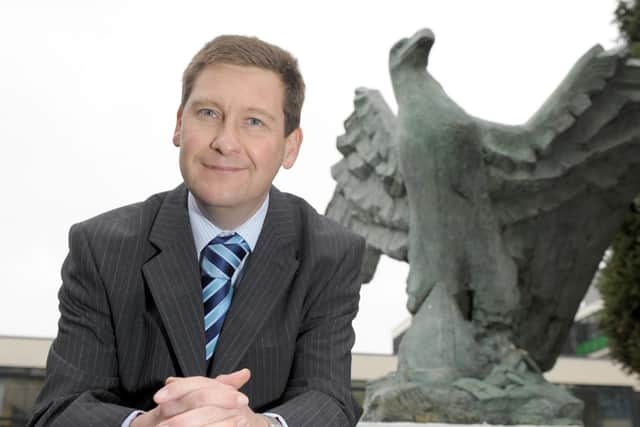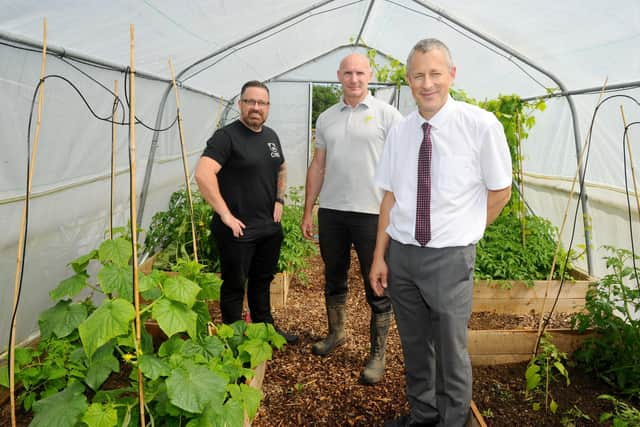‘Impossible’ – leading Portsmouth headteacher reacts to whole year group bubble proposal
and live on Freeview channel 276
The main concern is the proposal in secondary schools for whole year group bubbles, particularly for GCSE and A-level students, which St Edmund’s Catholic School headteacher, Simon Graham, has said is ‘impossible’ to put in place.
Mr Graham said: ‘The concept of a group bubble of 220 students in a school of 1,200 being moved around school for different lessons and with staggered lunch and break-times with the same number of staff is impossible to timetable.
Advertisement
Hide AdAdvertisement
Hide Ad‘It may be feasible in a primary school but to get all year groups through lunch separately, some pupils would have to start their lunch at 10am. The idea of social bubbles doesn’t really work anyway as most children have siblings from different year groups who they will inevitably come into contact with at home.’


Chris Anders, headteacher at Park Community School in Havant, agrees with children returning to school in September but feels the concept of whole-year group bubbles is not practical.
‘As a headteacher I’m being asked to manage something which I fundamentally believe is a bad ide,’ he said. ‘I think what has been published today allows the government to say all schools will go back in September but is simply putting the problem off to another day.
‘We are told infection rates are currently very low. We want to get on with getting all our children back in schools and I think on a practical level the only way to do this is to accept that if you are going to start getting a 1,000 people back into one place then it’s impossible to eliminate all risk.’


Advertisement
Hide AdAdvertisement
Hide AdPriory School headteacher, Stewart Vaughan, accepts the current proposals present ‘real problems’ but said that schools would ‘have to find a way’. One of the biggest challenges for Stewart is the ‘timetabling of specialist teaching spaces’ when pupils are restricted to year bubbles.
Mr Vaughan commented: ‘The commitment to get all students back in school is good news but one of the real challenges will be timetabling specialist rooms such as science laboratories.’
While the new guidelines don’t stipulate that social distancing must be adhered to it does specify it should be ‘maintained wherever possible’ with an expectation put on schools to ‘properly consider social distancing and put in place measures that suit their particular circumstances’. The guidelines go on to state ‘ideally, adults should maintain two metre distance from each other, and from children’.
This is an expectation which is also problematic for schools.
Advertisement
Hide AdAdvertisement
Hide AdMr Vaughan said: ‘This is undoubtedly going to create challenges when our premises return to full and we are managing children in classrooms and moving around corridors.’
Mr Graham added: ‘Young people naturally don’t want to social distance. Human contact is an essential element of growing up.’
Under the new guidelines, if there are two confirmed coronavirus cases in 14 days, all the pupils in that group bubble, or even the whole school, may have to be sent home. Mobile testing units will be sent to schools which have an outbreak.
Any member of staff dealing with a child who is displaying coronavirus symptoms should wear personal protective equipment (PPE) ‘if a distance of two metres cannot be maintained’.
Advertisement
Hide AdAdvertisement
Hide AdMr Anders said: ‘I’m concerned that come the autumn we are going to have a lot of children with normal coughs and colds which could lead to large numbers being sent home. We have been sent five sets of PPE from Hampshire County Council which on a typical November day could all be used before break time.’
Penalty notices will return
To enforce the expectation of school attendance, education secretary, Gavin Williamson, has confirmed that fixed penalty notice fines will return.
Headteachers have generally said they will initially take a sympathetic approach to individual circumstances – particularly in households where there may have been a vulnerable or shielded family member.
Mr Graham commented: ‘The message for all children to come to school is the right one but to fine parents at this stage is not the best way forward. There may be heightened anxiety, mental health problems and other underlying issues which need to be tackled to get children back into school.’
Advertisement
Hide AdAdvertisement
Hide AdMr Vaughan added: ‘There has to be a period of adjustment and individual circumstances need to be understood.’
Despite reservations about the practicalities of the plan, all headteachers who spoke to The News were adamant they wanted children to return but there needs to be an element of realism regarding both the risk and the practicalities of putting measures in place.
Mr Graham said: ‘I’m desperate for our children to return. But the first we often hear of plans being put in place is through the media. We could have done with knowing this two weeks ago which would have given us a month before the end of term to communicate with parents and to start putting measures in place.’
Mr Anders added: ‘Whatever social bubbles you put in place if you are going to put 30 children in a room breathing in the same air then there’s going to be a risk of infection. While infection rates are low I think we have to accept that and get on with it.’
Portsmouth City Council’s and the unions’ view
Advertisement
Hide AdAdvertisement
Hide AdIt’s a sentiment shared in the guidelines which accept returning to school ‘is not risk free’ but highlights ‘the balance of risk is now overwhelmingly in favour of children returning to school’.
The plan has generally been welcomed by Portsmouth City Council's cabinet member for education, Cllr Suzy Horton, with the caveat that the burden of responsibility has now been passed on to schools
Cllr Horton said: ‘I welcome the aspiration for all children to be back in school by September although it does place responsibility onto the schools to ensure it is as safe as possible to do so.
‘There has been a definite shift in emphasis on educational considerations with the terminology suggesting schools should adhere to the guidelines as best they can and to aim for as near normality as possible.’
Advertisement
Hide AdAdvertisement
Hide AdThe council’s shadow cabinet member for education, Terry Norton, added: ‘I welcome the news that schools will be fully reopening in September - the recovery of education is critical for this generation of schoolchildren. Portsmouth currently has around a quarter of its children back in school with no reported outbreaks.
‘Although this is positive news, I’m pleased that all staff, pupils and their families will have access to home testing kits if they develop symptoms. The sooner schools fully reopen the sooner we can shake off the negative stigma of schools being unsafe places to be.’
However, implementing plans for a September return may yet come into conflict with the teaching unions.
Portsmouth teacher and National Education Union president, Amanda Martin, commented: ‘The government has to be able to convince school staff that sufficient measures are in place to make it Covid secure for them to work in a class of 30 or more children with neither PPE or social distancing.
Advertisement
Hide AdAdvertisement
Hide Ad‘School leaders need clear guidance based on scientific evidence but instead they are faced with a government that is rushing through ideas that seem more based on hope than on science.’
A message from the Editor
Thank you for reading this story on portsmouth.co.uk. While I have your attention, I also have an important request to make of you.
With the coronavirus lockdown having a major impact on many of our advertisers - and consequently the revenue we receive - we are more reliant than ever on you taking out a digital subscription.
Subscribe to portsmouth.co.uk and enjoy unlimited access to local news and information online and on our app. With a digital subscription, you can read more than 5 articles, see fewer ads, enjoy faster load times, and get access to exclusive newsletters and content. Visit our Subscription page now to sign up.
Our journalism costs money and we rely on advertising, print and digital revenues to help to support them. By supporting us, we are able to support you in providing trusted, fact-checked content for this website.
Comment Guidelines
National World encourages reader discussion on our stories. User feedback, insights and back-and-forth exchanges add a rich layer of context to reporting. Please review our Community Guidelines before commenting.